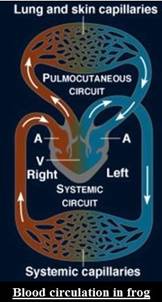
Describe the actions of the frog heart chambers during a cardiac cycle.
To write:
The actions of the heart chambers during a cardiac cycle in frog.
Introduction:
Heart is the vital organ of the circulatory system as it pumps blood all over the body. Human heart consists of four chambers: two upper chambers or atria and two lower chambers or ventricles. Blood passes across a valve before parting each heart chamber.
Explanation of Solution
Heart of frog:
The heart in frog consists of three chambers. There are two atrial chambers which drain into a single and common ventricle.
The pacemaker in the frog’s heart is present in the posterior side of the heart. The pacemaker is known as the sinus venosus. This sinus venosus is similar to the sinoatrial node inside the cardiac tissue of human.
Actions of frog heart chambers during a cardiac cycle are:
There occurs an atrial systole or atrial contraction. Then there is an atrial diastole or relaxation. This diastole is followed by a ventricle systole. Then ventricular systole is followed by a ventricle diastole. These actions complete one heart beat in the frog.
Blood circulation in frog by the action of the heart chambers is:

The three chambers in the frog’s heart are two atria and one ventricle. Blood exits the heart by the ventricle across a single truncus arteriosus. It is a short blood vessel that immediately bifurcates into two aortic arches (left and right) dorsal to the heart. These aortic arches then reunite and form a single aorta in the mid-dorsal part of the body cavity. Each aortic arch gives off a branch that runs to the lungs and skin where the oxygenation of blood takes place. Carotid arteries also divide into the aortic arches. These deliver to the head region.
Veins transport blood back to the left and right atria. Both the atria then drain into a single ventricle. Then again the blood from the ventricle enters into the pulmocutaneous or body circulation. As, there exists a single ventricle, there occurs some mixing of the oxygenated and deoxygenated blood. Ventricular folds are present that prevent a complete combination of the venous and arterial blood.
So, actions of the chambers of the frog heart involve an atrial systole followed by an atrial diastole. Atrial diastole is then followed by a ventricle systole which is further followed by a ventricle diastole.
Hence, actions of the chambers of the frog heart during a cardiac cycle involve an atrial systole followed by an atrial diastole. Atrial diastole is then followed by a ventricle systole which is further followed by a ventricle diastole.
Want to see more full solutions like this?
Chapter S3 Solutions
Laboratory Manual For Human Anatomy & Physiology
- Explain how the hormones of the glands listed below travel around the body to target organs and tissues : Pituitary gland Hypothalamus Thyroid Parathyroid Adrenal Pineal Pancreas(islets of langerhans) Gonads (testes and ovaries) Placentaarrow_forwardWhat are the functions of the hormones produced in the glands listed below: Pituitary gland Hypothalamus Thyroid Parathyroid Adrenal Pineal Pancreas(islets of langerhans) Gonads (testes and ovaries) Placentaarrow_forwardDescribe the hormones produced in the glands listed below: Pituitary gland Hypothalamus Thyroid Parathyroid Adrenal Pineal Pancreas(islets of langerhans) Gonads (testes and ovaries) Placentaarrow_forward
- Please help me calculate drug dosage from the following information: Patient weight: 35 pounds, so 15.9 kilograms (got this by dividing 35 pounds by 2.2 kilograms) Drug dose: 0.05mg/kg Drug concentration: 2mg/mLarrow_forwardA 25-year-old woman presents to the emergency department with a 2-day history of fever, chills, severe headache, and confusion. She recently returned from a trip to sub-Saharan Africa, where she did not take malaria prophylaxis. On examination, she is febrile (39.8°C/103.6°F) and hypotensive. Laboratory studies reveal hemoglobin of 8.0 g/dL, platelet count of 50,000/μL, and evidence of hemoglobinuria. A peripheral blood smear shows ring forms and banana-shaped gametocytes. Which of the following Plasmodium species is most likely responsible for her severe symptoms? A. Plasmodium vivax B. Plasmodium ovale C. Plasmodium malariae D. Plasmodium falciparumarrow_forwardStandard Concentration (caffeine) mg/L Absorbance Reading 10 0.322 20 0.697 40 1.535 60 2.520 80 3.100arrow_forward
- please draw in the answers, thank youarrow_forwarda. On this first grid, assume that the DNA and RNA templates are read left to right. DNA DNA mRNA codon tRNA anticodon polypeptide _strand strand C с A T G A U G C A TRP b. Now do this AGAIN assuming that the DNA and RNA templates are read right to left. DNA DNA strand strand C mRNA codon tRNA anticodon polypeptide 0 A T G A U G с A TRParrow_forwardplease answer all question below with the following answer choice, thank you!arrow_forward
 Concepts of BiologyBiologyISBN:9781938168116Author:Samantha Fowler, Rebecca Roush, James WisePublisher:OpenStax College
Concepts of BiologyBiologyISBN:9781938168116Author:Samantha Fowler, Rebecca Roush, James WisePublisher:OpenStax College Comprehensive Medical Assisting: Administrative a...NursingISBN:9781305964792Author:Wilburta Q. Lindh, Carol D. Tamparo, Barbara M. Dahl, Julie Morris, Cindy CorreaPublisher:Cengage Learning
Comprehensive Medical Assisting: Administrative a...NursingISBN:9781305964792Author:Wilburta Q. Lindh, Carol D. Tamparo, Barbara M. Dahl, Julie Morris, Cindy CorreaPublisher:Cengage Learning Human Biology (MindTap Course List)BiologyISBN:9781305112100Author:Cecie Starr, Beverly McMillanPublisher:Cengage Learning
Human Biology (MindTap Course List)BiologyISBN:9781305112100Author:Cecie Starr, Beverly McMillanPublisher:Cengage Learning Human Physiology: From Cells to Systems (MindTap ...BiologyISBN:9781285866932Author:Lauralee SherwoodPublisher:Cengage Learning
Human Physiology: From Cells to Systems (MindTap ...BiologyISBN:9781285866932Author:Lauralee SherwoodPublisher:Cengage Learning Biology: The Dynamic Science (MindTap Course List)BiologyISBN:9781305389892Author:Peter J. Russell, Paul E. Hertz, Beverly McMillanPublisher:Cengage Learning
Biology: The Dynamic Science (MindTap Course List)BiologyISBN:9781305389892Author:Peter J. Russell, Paul E. Hertz, Beverly McMillanPublisher:Cengage Learning





